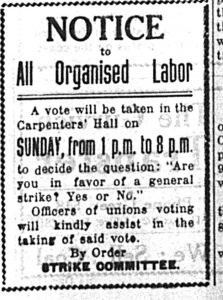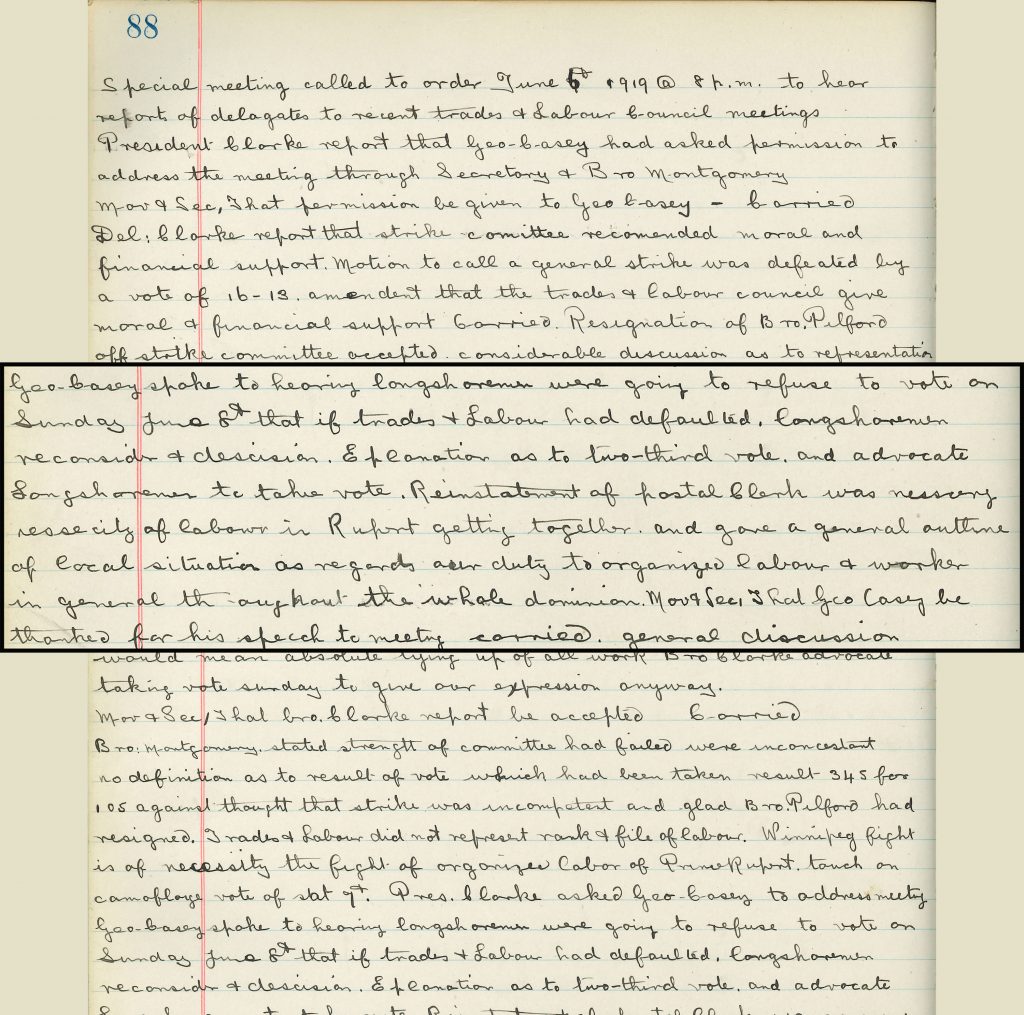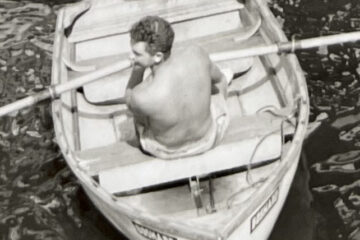The 1919 Prince Rupert General Strike
“A Duty to Organized Labour and Workers
Throughout the Whole Dominion”
When the Winnipeg General Strike began on May 15, 1919 sympathy strikes in communities across Canada soon broke out. In British Columbia, the heroic Vancouver sympathy strike and Victoria’s four day stoppage are often cited as examples. (see bibliography). Lesser known strikes occurred in smaller communities. One case is the City of Prince Rupert where a sympathetic strike began soon after the Winnipeg walk-out and on June 10, 1919 became a full-blown general strike. The Prince Rupert strike lasted until July 4.
The 1919 Prince Rupert General Strike was not easily accomplished. That it occurred at all is significant and demonstrates the rebellious spirit of working people in BC in 1919 extended to all regions of the province .
When Prince Rupert labour collectively agreed to strike in support of Winnipeg, it met with derision and outright anger among the local business community and editorialists at the two daily newspapers. There was also opposition from local union members who conceded to orders from international union headquarters to not participate. It took three separate votes for the Labour Council to reach a two-thirds threshold of support, and the full strike went ahead with nine of the city’s fifteen unions in solidarity.
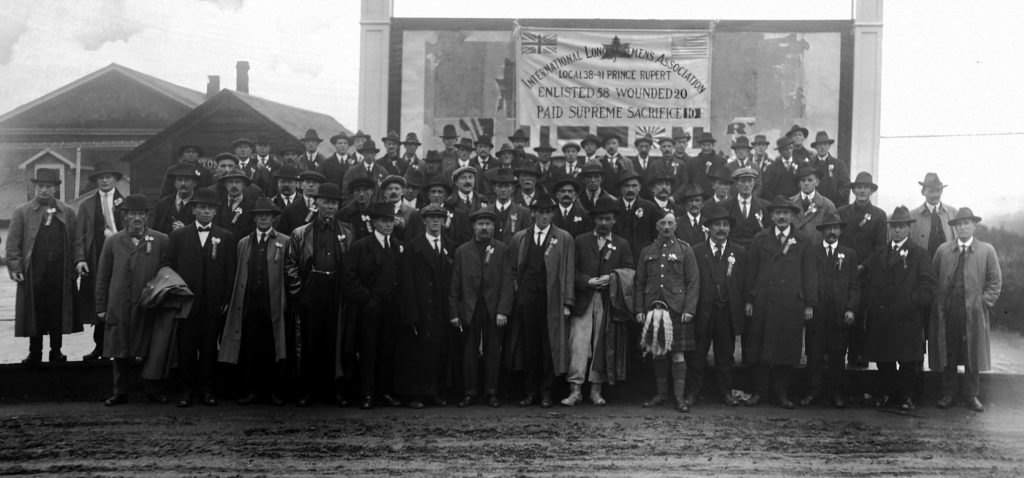
The Prince Rupert Longshoremen’s Union were solid supporters of the 1919 Prince Rupert General Strike. The union had suffered great losses during the First World War and understood the importance of solidarity with Winnipeg workers.. Photo credit: ILWU Local 505.
Like every other community in Canada, Prince Rupert was in turmoil in 1919. The First World War (1914-1918) had just ended, the dry-dock had sat idle throughout the war, the City reduced its workforce to a skeleton crew and relied on banks for municipal financing. Over 100 local men had died in the overseas carnage. Unemployment was high and inflation rampant.
In 1919, Prince Rupert was less than ten years old with a population of under 5,000 and organized labour had secured its role. The Carpenters Union constructed a hall in 1909 and the Prince Rupert Trades and Labor Council received its charter in 1912. Workers in the railway trades, construction and fisheries belonged to unions and affiliated under the Labour Council’s umbrella to pursue goals of common interest.
Following an east-west split at the Trades and Labour Congress Convention in Quebec City in 1918, the BC Federation of Labour took the unusual step of holding its 1919 convention in Calgary in March, then reconvened as the Western Labour Conference to re-organize workers along industrial lines under the radical banner of the One Big Union (OBU). Their actions put them in opposition to the national labour congress, whose membership included the international unions which the OBU opposed.
Prince Rupert was prominent and eagerly supported the policies passed at Calgary; of the 87 delegates at in March 1919, three were from Prince Rupert: George Casey (Canadian Fish Packers Union), Labour Council President Simon McDonald (International Typographical Union) and William Montgomery, (Longshoremen’s Association). Casey was also a Vice President on the BC Federation of Labour executive and a respected Prince Rupert Alderman.
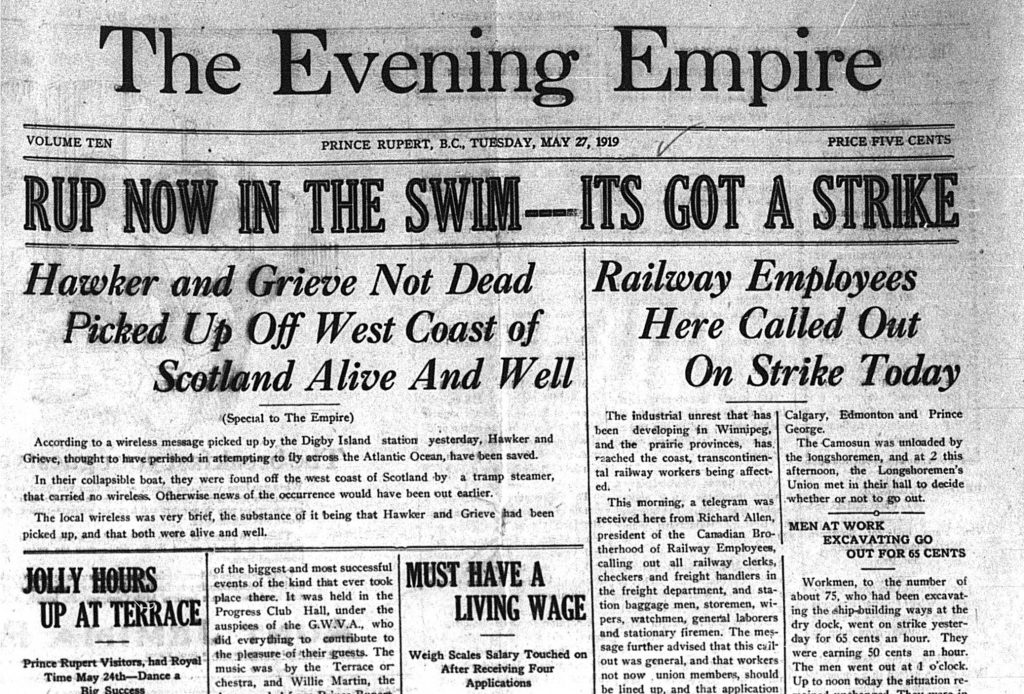 Prince Rupert’s first act of solidarity with Winnipeg was begun by railway workers on May 27, 1919. Members of the Canadian Brotherhood of Railway Employees (CBRE) at the Grand Trunk Pacific Railway were “called out” by telegram from their national President.
Prince Rupert’s first act of solidarity with Winnipeg was begun by railway workers on May 27, 1919. Members of the Canadian Brotherhood of Railway Employees (CBRE) at the Grand Trunk Pacific Railway were “called out” by telegram from their national President.
The hand-written minutes from 1919 of the Prince Rupert International Longshore Association (ILA) Local 38-41, have miraculously survived and provide a first-hand account from labour’s perspective on how the Prince Rupert General Strike progressed. After being called out on strike on May 27, a delegation of CBRE members headed to the ILA Hall where a special meeting had been called for 2pm. The railway workers sought the support of the ILA to ensure their picket lines would be honoured, and it was readily offered. A unanimous vote agreed “that we do not handle any freight incoming or outgoing in connection with railway shed and car work”.
That same evening, the Prince Rupert Trades and Labor Council established a three-member strike committee to assist unions whose members were participating in sympathy strikes with Winnipeg. The labour council also passed a motion to thank the Longshoremen’s Union for its “splendid and prompt support” of the men by refusing to handle cargo bound in or out on the railway.”
On May 30 the Fish Packers Union agreed to process any fish that was “in port” or “coming in” but would not handle ‘hot cargo’ after the strike had begun.
On the evening of May 30, 1919, a lengthy meeting of Prince Rupert labour was convened at the Carpenter’s Hall to discuss the situation. The union hall was full; people were standing outside peering through the windows and straining to listen to the debate. The vote was 345 to 105 to give the Strike Committee authority to call a General Strike in Prince Rupert. Only the Retail Clerks Union and the International Brotherhood of Electrical Workers were opposed.
On June 1, Grand Trunk Pacific management threatened to dismiss its striking workers if they did not return to work immediately. The railway workers refused and voted unanimously “to stay out till the Winnipeg strike was settled and were out for a fight to the finish”. The CBRE leadership headed back to the Longshoremen’s hall to report on the new development. The Longshoremen assured their CBRE brothers they were “fully alive to the situation and were ready to give all necessary support when time was ripe”.
On June 3, the Vancouver sympathetic strike began; the news reached Prince Rupert by telegram and at 7 am on June 4 the Rupert railway yards and the harbour were behind ILA pickets. On June 5 the Prince Rupert Trades and Labour Council met to consider a resolution declaring a full general sympathetic strike in Prince Rupert for June 9. It was defeated by a vote of 16 to 13. (It is assumed by the small numbers that this was a delegated meeting, not a full membership vote.)
The meeting passed a weakly worded recommendation from the Strike Committee that they offer only moral and financial support to those unions on strike. The Prince Rupert General Strike was in peril and the Longshoremen’s Union was furious. Their representative on the Strike Committee resigned.
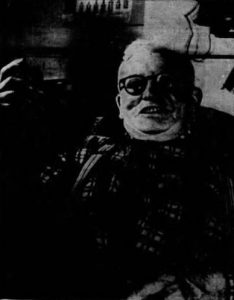
George Casey (pictured in 1952) was a key figure during the creation of the One Big Union, and during Prince Rupert’s 1919 General Strike.
George Casey, on behalf of the Labour Council, was summoned by the Longshoremen on June 6 to do some explaining. Casey listened as member after member expressed outrage at the June 5 vote. Longshoremen blamed the outcome on smaller unions who had cast more votes than they were entitled. One Longshoreman told the meeting he thought the “strike [committee] was incompetent” and was “glad Bro. Pilford had resigned”. Labour Council delegates, they said, “did not represent the rank and file of labour”.
Casey, who had organized local support for the OBU, was a vocal supporter of the general strike and told the Longshoremen that a new vote would be held June 8; he urged them to participate. This time the vote would require a two-thirds majority. With typical fiery rhetoric, Casey said the labour community in Prince Rupert had a “duty to organized labour and workers in general throughout the whole dominion”.
Five hundred and fifteen Prince Rupert union members cast their votes on June 8 and the two-thirds majority was achieved, but by just 2 votes (345 to 170). Opposition to a general strike had grown beyond the Retail Clerks and Electric Workers to include the Typographical Union, Engineers and Carpenters.
Many Prince Rupert unions had yielded to pressure by their International executives. The Typographical Union, Retail Clerks and Electric Workers told the newspapers that they were prevented from striking by their International Unions’ rules.
By now, tempers were fraying at the Labour Council and internal divisions became public. Acting Secretary Ralph Rose blasted the unions who did not support the strike. Rose told the Daily News he “dislike[d] the action of…unions, who first had expressed themselves in favor of the strike, but when it was put up to them refused to come out”.
Over at the Longshoremen’s Hall, members discussed at some length “what kind of an organization the Retail Clerks was in Prince Rupert”. The longshoremen established their own Strike Committee comprised of the union executive who would deal with matters pertaining to their members.
 The Labour Council pressed ahead and announced the Prince Rupert General Strike would start on June 10 at 6 pm, with nine unions participating. At the agreed-upon time longshoremen, loggers, boilermakers, machinists, pipe-fitters, railway checkers, freight handlers and fish packers all joined in as did about a dozen machinists who worked at the drydock.
The Labour Council pressed ahead and announced the Prince Rupert General Strike would start on June 10 at 6 pm, with nine unions participating. At the agreed-upon time longshoremen, loggers, boilermakers, machinists, pipe-fitters, railway checkers, freight handlers and fish packers all joined in as did about a dozen machinists who worked at the drydock.
Railway freight and coastal steamships stopped running. Fish boats went to Alaska or Seattle to unload. The Evening Empire (the newspaper where Labour Council President Simon Mcdonald worked) published the regular Strike Bulletins written by the Prince Rupert Strike Committee. Local businesses were accused of price gouging. A citizens committee was formed to “maintain law and order” even though not a single act of violence had been threatened or occurred.
Despite reports in the newspapers that men were drifting back to work, the strikers persisted even as events in Winnipeg began to unravel. On June 26 the Winnipeg General Strike came to a bloody end, but Prince Rupert labour was not backing down. It took one last stand on another principle: reinstatement of the strikers.
Grand Trunk Pacific management had blacklisted ten workers – including two union leaders – who had participated in the strike. Casey urged everyone to stay united. “Let us all go back together or stay out until we do”.
A mass meeting filled the Westholme Theatre on 2nd Avenue (the Carpenter’s Hall being too small) on June 29. George Casey chaired the meeting and declared “we will stick it out until we are starved out and become busted and have to leave town.”
Prince Rupert labour was united in the cause, whether or not they had participated in the strike, with the lone exception of the Retail Clerks who still refused their backing . Engineers, machinists, fishermen, teamsters and carpenters pledged money and support. Telegrams were sent to Smithers, Fort George, Edmonton and Vancouver advising of the Prince Rupert situation. The General Strike would be expanded on July 4 at 6 pm.
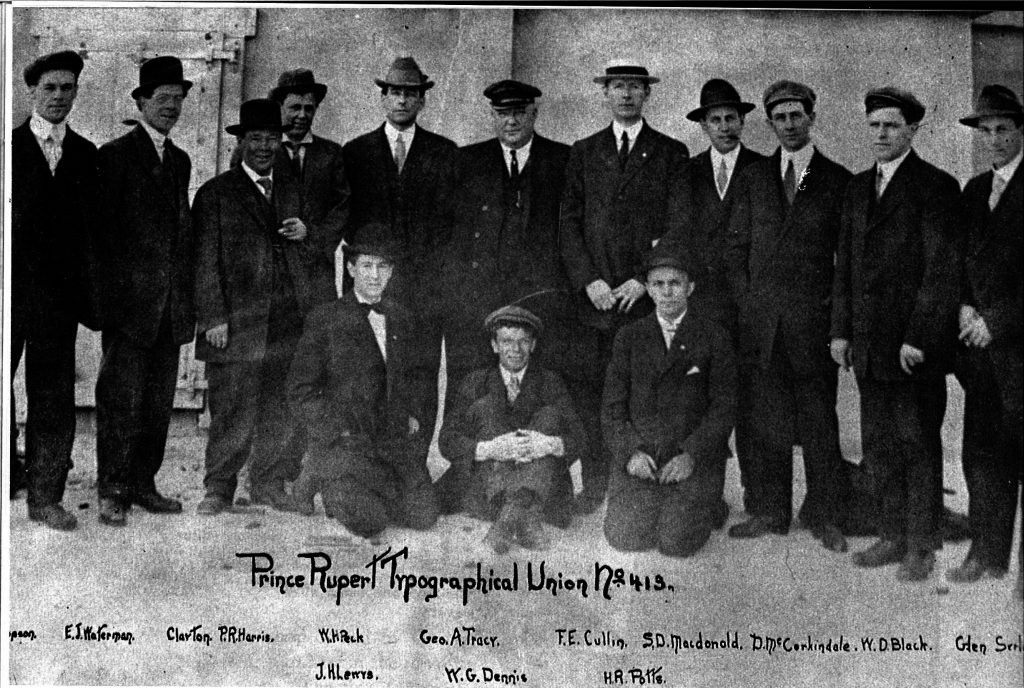
The Prince Rupert local of the International Typographical Union. Simon MacDonald (fourth from right, standing) was President of the Prince Rupert Trades and Labour Council and supported the creation of the One Big Union at the Western Labour Conference in Calgary in March 1919. His union did not participate in the Prince Rupert sympathetic strike, but the Evening Empire where he worked published Strike Committee Bulletins. Photo Credit: Museum of Northern BC.
At 5:30 pm on July 4 the Strike Committee reported the “terms of the settlement are as good as we can expect under the circumstances, and that we advise the strikers to return to work, thereby calling off the General Strike in Prince Rupert”. The vote was 15 to 12 in favour. The Prince Rupert sympathetic strike ended with a final show of solidarity among the working class.
Prince Rupert had endured many local strikes in its short history, but the 1919 Prince Rupert General Strike was different. It was based entirely on support for workers over a thousand miles away who were fighting for the right to collective bargaining and a living wage.
In 1916, Prince Rupert Labour Council President Simon Macdonald declared labour would “make the metropolis of northern British Columbia one of the strongest Labor cities on the Pacific coast”. The 1919 Prince Rupert General Strike marked a milestone on the road to building a strong labour movement in northwest BC.
Sources:
General Minutes of Meetings, ILA Prince Rupert Local 38-41. The International Longshoremen’s and Warehousemen’s Union (Canadian Area fonds), University of British Columbia Library Rare Books and Special Collections, Vancouver.
Prince Rupert Trades and Labour Council Fonds, University of British Columbia Rare Books and Special Collections, Vancouver
The Daily News and The Evening Empire, Prince Rupert Public Library.
The BC Federationist, SFU Library.
